 It is not emptying your mind. The instructor explains to the class,
It is not emptying your mind. The instructor explains to the class,
Meditation has got nothing to do with blanking your mind. My favourite quote on yoga is “If you want your mind to go blank, get your best friend to give you a healthy blow on the head.”
Oh God, but my mind is blank. Should it not be? Think about things. Concentrate. I mean, meditate. So it’s not just emptying your mind then?
You wouldn’t want to encourage your mind to be blank, because your mind is designed in a way that is supposed to connect you with the world around you. So why would you ask your heart to stop beating, why would you ask your digestive system to stop working?
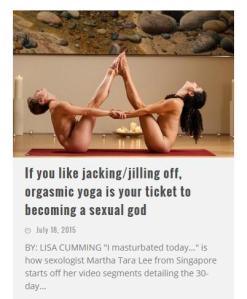 Didn’t Houdini slow his heart down or his breathing so he could escape from padlocks under water? No matter. Some gentle stretches. She asks us to move our hands in front of us, and to project an imaginary ball of light in our hands. Oh wow! I can see it, right there in my hands, a big imaginary ball of love or cosmic libido. My body and I are one! Meditating is pretty far out.
Didn’t Houdini slow his heart down or his breathing so he could escape from padlocks under water? No matter. Some gentle stretches. She asks us to move our hands in front of us, and to project an imaginary ball of light in our hands. Oh wow! I can see it, right there in my hands, a big imaginary ball of love or cosmic libido. My body and I are one! Meditating is pretty far out.
We are going to be practicing slow movement, controlled movement, to match our breath, so that our awareness can follow.
I like the stretches and the breathing and the ball of light, and the lying down. I could lie down all day, all night even, just breathing. She tells us to touch one nostril with your thumb and the other with your finger and breathe in through the left nostril and out through the right. But I can’t. I can’t breathe through my nose. This is agony. This is excruciating. I have never been so frustrated. This is not relaxing. Meditation is sheer hell.
What we are trying to achieve through meditation, a sense of stillness, a sense of peace, tap into that sense of stillness and peace within us, something that you carry with you all the time wherever you go.
Seriously, how do they get away with it, the Bedroom Tax and the Welfare Bill, the death of B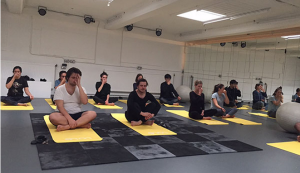 obby Sands and parking tickets. I definitely did not ask to be born. This is cruel. My body has dissolved into feelings. At that moment I notice that the ball of light in my hands is a horrendous flaming ball of pure hate.
obby Sands and parking tickets. I definitely did not ask to be born. This is cruel. My body has dissolved into feelings. At that moment I notice that the ball of light in my hands is a horrendous flaming ball of pure hate.
We are not looking for achieving something unattainable, we are tapping into something that is within – sense of stillness, sense of peace, sense that everything is well.
Everything is not well. The meditation session was not cathartic. After it’s over the guy next to me says, with a bovine docility, that he found it peaceful. In my mind a menagerie of Boschian monsters commit grave acts of bestial cruelty to each other in a landscape of flames and death.
In case you came here with the expectation of blanking your mind, it is not what we are looking for.
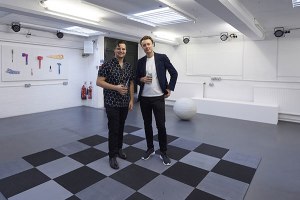 In Week 38 of Fig-2 Josh Wright and Guillaume Vandame turned the ICA studio space into a participatory art gym. The idea was to invite artists as well as exercise instructors, and encourage people to try new things and to promote healthy living as opposed to the impossible ideals of body image, with a social platform to discuss issues inspired by Marjolijn Dijkman’s Salon sessions held in Week 22 of Fig-2 which used the space as an open forum for discussion.
In Week 38 of Fig-2 Josh Wright and Guillaume Vandame turned the ICA studio space into a participatory art gym. The idea was to invite artists as well as exercise instructors, and encourage people to try new things and to promote healthy living as opposed to the impossible ideals of body image, with a social platform to discuss issues inspired by Marjolijn Dijkman’s Salon sessions held in Week 22 of Fig-2 which used the space as an open forum for discussion.
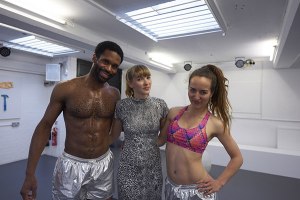 During the week there were sessions of Pilates, Zumba, Chi Kung, meditation, and eight types of yoga- Ashtanga, Vinyasa, Hatha, Meditation, Yin, Dru, as well as the mysterious “Everlasting Yoga” sessions run by artist Karimah Ashadu, the movement and meditation session that so severely stressed me out, and VOGA, an ungodly but logical mashup of Yoga and Voguing, the ‘strike a pose’ semi-static dance style that Madonna stole off the New York gay scene; logical because yoga is also a kind of semi-static dance of held poses, and ungodly because oh God just Madonna.
During the week there were sessions of Pilates, Zumba, Chi Kung, meditation, and eight types of yoga- Ashtanga, Vinyasa, Hatha, Meditation, Yin, Dru, as well as the mysterious “Everlasting Yoga” sessions run by artist Karimah Ashadu, the movement and meditation session that so severely stressed me out, and VOGA, an ungodly but logical mashup of Yoga and Voguing, the ‘strike a pose’ semi-static dance style that Madonna stole off the New York gay scene; logical because yoga is also a kind of semi-static dance of held poses, and ungodly because oh God just Madonna.
![victoria-beckham_784x0[1]](https://fig2loyaltycard.wordpress.com/wp-content/uploads/2015/10/victoria-beckham_784x01.jpg?w=300&h=194) Vandame and Wright are strongly influenced by Vanessa Beecroft, and their week was in a sense an application of her sculptural use of actual human bodies. The participants in the classes become part of the human sculpture, as well as integral to what are in effect participatory performances. Guillaume says “the classes work within this framework about body image, gender, sexuality, etc. but are also much about chance encounters and possibility — what can happen in these situations and questioning expectations of both performance art and traditional exercise classes.”
Vandame and Wright are strongly influenced by Vanessa Beecroft, and their week was in a sense an application of her sculptural use of actual human bodies. The participants in the classes become part of the human sculpture, as well as integral to what are in effect participatory performances. Guillaume says “the classes work within this framework about body image, gender, sexuality, etc. but are also much about chance encounters and possibility — what can happen in these situations and questioning expectations of both performance art and traditional exercise classes.”
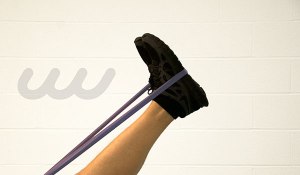 In the sessions from three invited artists, the idea of a performance and exercise class as participatory performance were mixed up so an exercise class that is instructive becomes a participatory art event. Visitors are in a sense objectified, becoming sculptures within the installation. Objectification is a dangerous subject, beginning with how people are perceived and then defined and then repressed according to single objectified aspects of the their sex, gender, race, culture. Tellingly, the doors to the space stayed open, to foreground the aim of inclusivity. So the show’s repurposing of objectification takes issues or representation of the female body as a starting point and extends it to issues of race, sexuality, and so on through the whole list of ‘Tory low priorities’. It addresses perceived alienating effects of performance art (and indeed exercise) by inviting people into the performance.
In the sessions from three invited artists, the idea of a performance and exercise class as participatory performance were mixed up so an exercise class that is instructive becomes a participatory art event. Visitors are in a sense objectified, becoming sculptures within the installation. Objectification is a dangerous subject, beginning with how people are perceived and then defined and then repressed according to single objectified aspects of the their sex, gender, race, culture. Tellingly, the doors to the space stayed open, to foreground the aim of inclusivity. So the show’s repurposing of objectification takes issues or representation of the female body as a starting point and extends it to issues of race, sexuality, and so on through the whole list of ‘Tory low priorities’. It addresses perceived alienating effects of performance art (and indeed exercise) by inviting people into the performance.
 Zing Tsjeng has written in Vice about “This is insanity!” the class/art performance led by Turner nominee Marvin Gaye Chetwynd, giving such a vivid and amazing account that it made me wonder if I was even at the same event.
Zing Tsjeng has written in Vice about “This is insanity!” the class/art performance led by Turner nominee Marvin Gaye Chetwynd, giving such a vivid and amazing account that it made me wonder if I was even at the same event.
INSANITY® is a provocatively competitive workout – the hardest ever! says the promo material. Chetwynd explained the hideous beast and took the class through some of its moves. It involves high-intensity one-minute bursts of strenuous activity (we did thirty seconds) followed by relative chill. This I guess means the body can’t become adjusted to either, which makes it work harder. It’s obviously stupid, but I suppose some idiots want to give themselves heart attacks.
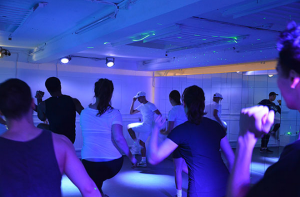 Adham Faramawy’s “Post Rave Sweat Fatigue Workshop” was a high-intensity session combining the dance moves of rave with standard aerobics. I enjoyed this very much, but it’s hard to dance. An hour of rave anthems was pretty tiring. How the hell did we do this all night long in the nineties? Oh, drugs. Drugs were pretty good, right? I’m glad we got those tattoos.
Adham Faramawy’s “Post Rave Sweat Fatigue Workshop” was a high-intensity session combining the dance moves of rave with standard aerobics. I enjoyed this very much, but it’s hard to dance. An hour of rave anthems was pretty tiring. How the hell did we do this all night long in the nineties? Oh, drugs. Drugs were pretty good, right? I’m glad we got those tattoos.
![tumblr_l8brdwNFqL1qdazefo1_500[1]](https://fig2loyaltycard.wordpress.com/wp-content/uploads/2015/10/tumblr_l8brdwnfql1qdazefo1_5001.jpg?w=300&h=200) High-intensity exercise is one thing, but nothing compared to what artists and bodybuilders have put themselves through. Francesca Steele is a kind of case study for pushing the limits of body modification as both an art and personal project. She was featured in the Superhuman exhibition at the Wellcome Collection, a show about body modification, and in the first salon discussion session at Fig-2 she spoke about her lifestyle and being a bodybuilder as an art project she did in 2008, physically changing her body and how that changed her identity, particularly regarding gender. Her diet was so rigorous and extreme, full of eggs and spinach and drugs, that upon being invited to dinner with art legend Marina Abramovic she declined because she didn’t want to deviate from her diet. It caused such a personal strain to the extent that she ended up divorced from her husband.
High-intensity exercise is one thing, but nothing compared to what artists and bodybuilders have put themselves through. Francesca Steele is a kind of case study for pushing the limits of body modification as both an art and personal project. She was featured in the Superhuman exhibition at the Wellcome Collection, a show about body modification, and in the first salon discussion session at Fig-2 she spoke about her lifestyle and being a bodybuilder as an art project she did in 2008, physically changing her body and how that changed her identity, particularly regarding gender. Her diet was so rigorous and extreme, full of eggs and spinach and drugs, that upon being invited to dinner with art legend Marina Abramovic she declined because she didn’t want to deviate from her diet. It caused such a personal strain to the extent that she ended up divorced from her husband.
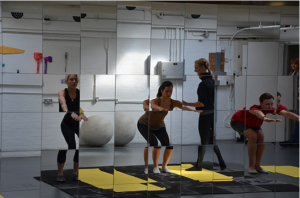 At the second salon session Fig-2 curator Fatoş Üstek theorized that the week invites a “critical framework” in which we discuss what forces are at play in “subjectivity and socially engaged art, how we define what is a healthy body and how art deals with this modern subject”. The mirrors along the side of the ‘gym’ were intentionally fragmented, as a visual comment on body image, which was pretty neat.
At the second salon session Fig-2 curator Fatoş Üstek theorized that the week invites a “critical framework” in which we discuss what forces are at play in “subjectivity and socially engaged art, how we define what is a healthy body and how art deals with this modern subject”. The mirrors along the side of the ‘gym’ were intentionally fragmented, as a visual comment on body image, which was pretty neat.
https://twitter.com/fig2london/status/648117591127498752
Developing this theme, three TVs showed one-hour edits of exercise and dance routines taken from movies and videos from the 1970s-80s. Guillaume explains “The exercise videos formally deal more with wider issues of representation and identity in terms of nationality and race — how these identities are constructed and formed across various cultures at various points in time. As well the issues of beauty, normality and difference on display – what it means to be masculine or feminine or the assumption that the individuals are heterosexual because they conform to a heteronormative ideology/society.”
That sounds very theory heavy, but it really resonates. I’ve always had a problem with these kinds of videos. They’re just so sexy. I can’t desexualise them, if anyone can. Can you? The lines of the body, particularly the crotch, are emphasised by the tight-fitting lycra gymwear. It brings out my inner prude. It’s something about the screen, whereas in real life nothing is at all sexy. Rhythmic movements of the pelvis are inherently embarrassing.
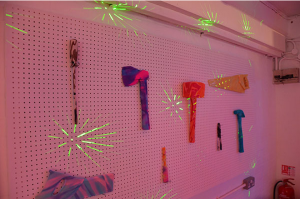 Appropriately, therefore, one sculptural aspect of the show was along one wall tools wrapped in lycra. Tools, wrapped in lycra. But seriously, ahem, it’s emblematic of the show’s mixing up of high and low culture to present the hard utilitarian teleology of hammers and saws wrapped up in the soft gaudy kitsch of spandex.
Appropriately, therefore, one sculptural aspect of the show was along one wall tools wrapped in lycra. Tools, wrapped in lycra. But seriously, ahem, it’s emblematic of the show’s mixing up of high and low culture to present the hard utilitarian teleology of hammers and saws wrapped up in the soft gaudy kitsch of spandex.
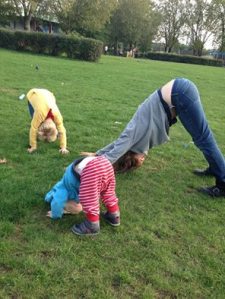 The classes and events I went to over the week involved me in physical activities that were well out of my comfort zone. What you’re reading now is in a sense a sequel to my piece for Week 27 of Fig-2 in which I dwelt on the chance encounter of my misanthropy and self-hatred with the spiritual and physical rhapsodies of Kundalini Yoga. With hilarious consequences, of course.
The classes and events I went to over the week involved me in physical activities that were well out of my comfort zone. What you’re reading now is in a sense a sequel to my piece for Week 27 of Fig-2 in which I dwelt on the chance encounter of my misanthropy and self-hatred with the spiritual and physical rhapsodies of Kundalini Yoga. With hilarious consequences, of course.
I do have a cosmic streak, so I wondered if my broadly positive reaction to Kundalini was more about that rather than the exercise side, and whether Week 38 would answer this. In the case of me getting so stressed out in the meditation class, clearly not.
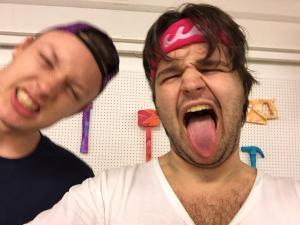 The yoga session on Sunday morning was a classic straight-man funny-man double act with Josh (literally straight) performing standard yoga moves, while Guillaume (literally funny) plugged into his iPod and singing along to a playlist of pop songs themed around breathing. The Daniel Johnston-like tuneless strangling of Taylor Swift and Sting was a disruptive art intervention into yoga. It actually made it easier for me to concentrate on the yoga; a sort of focusing distraction. I’m the sort of ADHD guy who generally has two TVs and a radio on while I’m writing while I’m driving while I’m on the tube while I’m on the phone, masturbating and making charcoal sketches.
The yoga session on Sunday morning was a classic straight-man funny-man double act with Josh (literally straight) performing standard yoga moves, while Guillaume (literally funny) plugged into his iPod and singing along to a playlist of pop songs themed around breathing. The Daniel Johnston-like tuneless strangling of Taylor Swift and Sting was a disruptive art intervention into yoga. It actually made it easier for me to concentrate on the yoga; a sort of focusing distraction. I’m the sort of ADHD guy who generally has two TVs and a radio on while I’m writing while I’m driving while I’m on the tube while I’m on the phone, masturbating and making charcoal sketches.
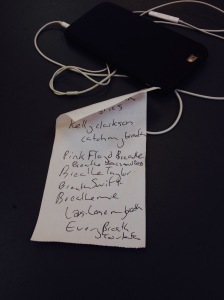 The session was nothing like my previous yoga session. It definitely felt like art, art as sustained wind-up, the neo-Dadaism of Fluxus and Naim June Paik. One of the other participants was sustainedly wound up and began ignoring Josh and performing her own yoga shapes, before finally leaving the room for a few minutes, then returning, resuming her own thing, and finally getting so frustrated with Guillaume’s off-key singing that she exploded “Shut up!”
The session was nothing like my previous yoga session. It definitely felt like art, art as sustained wind-up, the neo-Dadaism of Fluxus and Naim June Paik. One of the other participants was sustainedly wound up and began ignoring Josh and performing her own yoga shapes, before finally leaving the room for a few minutes, then returning, resuming her own thing, and finally getting so frustrated with Guillaume’s off-key singing that she exploded “Shut up!”
In the process of turning the studio space into an ‘art gym’ one of the interesting references that came up in the salons was to Marc Augé’s concept of ‘non-places’, those liminal spaces that are both or neither somewhere or nowhere – airports, shopping malls, motorways, supermarkets – and, why not, the gym. “The art of supermarkets, convenience stores, and so on have been explored,” Guillaume says, “but no one’s really explored the art of going to the gym. There have been references to the body throughout modern art and art history, but this context especially is unique.”
![timthumb.php_1[1]](https://fig2loyaltycard.wordpress.com/wp-content/uploads/2015/10/timthumb-php_11.png?w=200&h=300) In Non-places: An Introduction to Supermodernity Marc Augé draws a distinction between “anthropological places” formed by social bonds and collective history, and “non-places” of atomized, individual travel and consumption: “If a place can be defined as relational, historical and concerned with identity, then a space which cannot be defined as relational, or historical, or concerned with identity will be a non-place.” (p63).
In Non-places: An Introduction to Supermodernity Marc Augé draws a distinction between “anthropological places” formed by social bonds and collective history, and “non-places” of atomized, individual travel and consumption: “If a place can be defined as relational, historical and concerned with identity, then a space which cannot be defined as relational, or historical, or concerned with identity will be a non-place.” (p63).
 “Clearly the word ‘non-place’ designates two complementary but distinct realities: spaces formed in relation to certain ends (transport, transit, commerce, leisure), and the relations that individuals have with these spaces […] As anthropological places create the organically social, so non-places create solitary contractuality. Try to imagine a Durkheimian analysis of a transit lounge at Roissy!” (p76)
“Clearly the word ‘non-place’ designates two complementary but distinct realities: spaces formed in relation to certain ends (transport, transit, commerce, leisure), and the relations that individuals have with these spaces […] As anthropological places create the organically social, so non-places create solitary contractuality. Try to imagine a Durkheimian analysis of a transit lounge at Roissy!” (p76)
It is not that the gym does not have a culture or that it’s not concerned with identity. For many the gym is active in the development and expression of their identity. It’s a hot-house for growing bodies. However, that phrase “solitary contractuality” crashes down upon it. Most people in the gym are alone. Nobody talks to each other, or exchanges are limited to a few technical reflections on abs or nutrition. It’s like being on the tube, another arena within which one is profoundly solitary not least because one is crammed into a tin with countless other people, none of whom you may interact with, not in conversation, not even making eye contact.
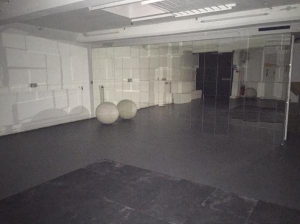 Gyms can be sterile, dehumanized environments that can be alienating or estranging, fuelling the suspicion of the exercise shy that it’s not for us, or that it’s for someone else, a body of people from which we are excluded just as ‘homeless spikes’ are not intended to promote a nicer society. “The non-place is the opposite of Utopia: it exists, and it does not contain any organic society.” (p90).
Gyms can be sterile, dehumanized environments that can be alienating or estranging, fuelling the suspicion of the exercise shy that it’s not for us, or that it’s for someone else, a body of people from which we are excluded just as ‘homeless spikes’ are not intended to promote a nicer society. “The non-place is the opposite of Utopia: it exists, and it does not contain any organic society.” (p90).
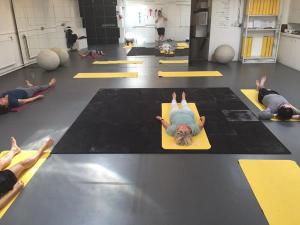 Solitary contractuality even extends to communal activities: exercise classes such as yoga or aerobics. Everyone is performing the same acts together, but all mediated through the class leader and each without reference to any other person in the room. It’s not a band, where if the drums stop you’ll notice, it’s not even like an orchestra where you could afford to have a few viola players pass out before anyone noticed anything was up. In these classes you are completely interchangeable, not even a cog in a machine for generating exercise, and if the gym is a non-place, then in the gym class you’re a non-person.
Solitary contractuality even extends to communal activities: exercise classes such as yoga or aerobics. Everyone is performing the same acts together, but all mediated through the class leader and each without reference to any other person in the room. It’s not a band, where if the drums stop you’ll notice, it’s not even like an orchestra where you could afford to have a few viola players pass out before anyone noticed anything was up. In these classes you are completely interchangeable, not even a cog in a machine for generating exercise, and if the gym is a non-place, then in the gym class you’re a non-person.
![2000px-RegisteredTM.svg[1]](https://fig2loyaltycard.wordpress.com/wp-content/uploads/2015/10/2000px-registeredtm-svg1.png?w=150&h=150) I was surprised but not surprised to learn that Zumba® is a registered trademark. So is INSANITY®. I have kind of respect for the holistic integrity of Kundalini Yoga but you do have to wonder if the highly invented and marketed Zumba – never mentioned without its ® – isn’t blatantly like the Scientology of exercise regimes. It’s a huge turnoff, that ®, a reminder of the strongly capitalistic impetus of exercise regimes. That your body is a product that you sell to make you a better machine to generate revenue for the capitalist machine.
I was surprised but not surprised to learn that Zumba® is a registered trademark. So is INSANITY®. I have kind of respect for the holistic integrity of Kundalini Yoga but you do have to wonder if the highly invented and marketed Zumba – never mentioned without its ® – isn’t blatantly like the Scientology of exercise regimes. It’s a huge turnoff, that ®, a reminder of the strongly capitalistic impetus of exercise regimes. That your body is a product that you sell to make you a better machine to generate revenue for the capitalist machine.
![61b5ee51cbea456667138efaa4892292.image.435x431[1]](https://fig2loyaltycard.wordpress.com/wp-content/uploads/2015/09/61b5ee51cbea456667138efaa4892292-image-435x4311.jpg?w=300&h=297) By reclaiming the gym in an art context, Vandame and Wright perhaps suggested some ways in which we can go beyond the depressing eighties elements of exercise culture and really grow ourselves.
By reclaiming the gym in an art context, Vandame and Wright perhaps suggested some ways in which we can go beyond the depressing eighties elements of exercise culture and really grow ourselves.
What I’d like to see is more of these free outdoor gyms. I walk past one in Anerley several times a week, and always think that’s bloody brilliant that is. Obviously I’m too lazy to actually use it, but I’d like to see these things everywhere, because proper gyms are expensive and terrifying. There is a massive moral panic about the burgeoning obesity crisis, so why don’t we build public gyms? Healthy living shouldn’t just be the preserve of the middle classes and the rich.

